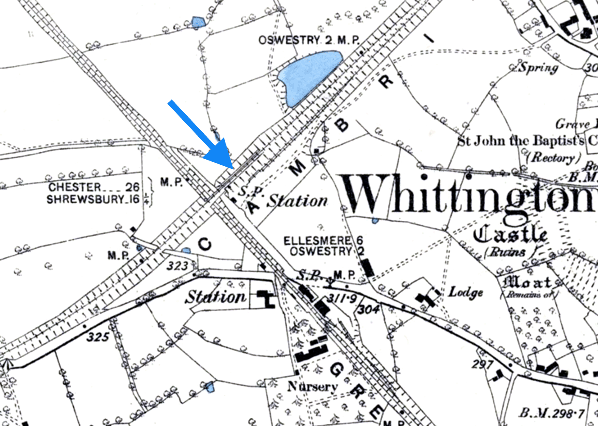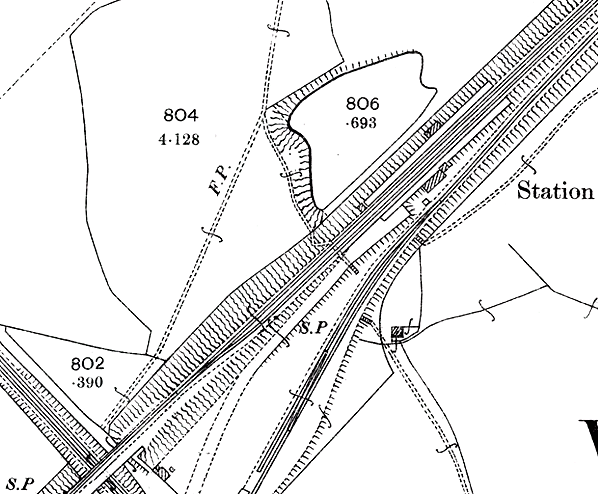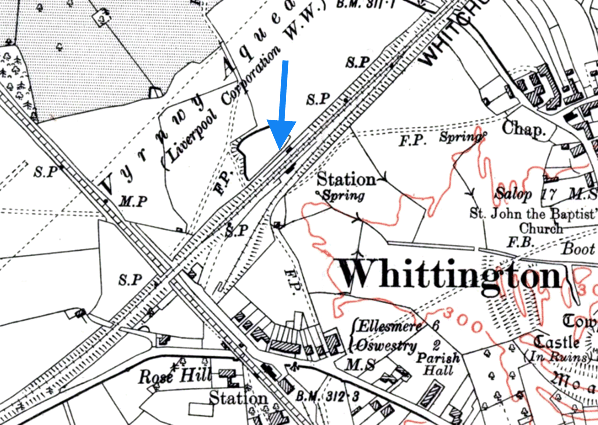Whittington High Level station, which opened as Whittington, was situated on what became the Cambrian Railway (CR) main line from Whitchurch to Welshpool. The section of line on which the station was located was originally promoted and built by the Oswestry, Ellesmere & Whitchurch Railway (OE&WR) as part of a line between Oswestry and Whitchurch. The first section of the line officially opened from Whitchurch to Ellesmere on 4 May 1863. On 25 July 1864 the Oswestry & Newtown Railway and the OE&WR amalgamated with the Newtown & Machynlleth Railway and the Llanidloes & Newtown Railway to form the CR (Joined in 1865 by the Aberystwyth & Welsh Coast Railway). Just two days later, on 27 July 1864 the section of line from Ellesmere to Oswestry opened for business. Whittington station opened on this date. By 1866 the CR had a main line running all the way from Whitchurch to Aberystwyth.
 |
The station was 1 mile 79 chains east of Oswestry located to the west of the village of Whittington, and just to the east of the Great Western Railway (GWR) Shrewsbury and Chester line which had opened on 14 October 1848. The GWR had also had a Whittington station located a short distance to the south of the CR line. The CR passed over the GWR line by means of a bridge and continued eastwards on an embankment. Access to the station was via a small lane that ran parallel to the GWR line (which runs north-south). Originally the station was located adjacent to the bridge that carried the lane under the line. There was a small building at ground level from which steps led up to a single platform which was located on the south side of the single-track railway.
The station had a small goods yard which consisted of two sidings that branched off from the main line half a mile to the east and descended to ground level adjacent to the passenger station on the south side of the line. The sidings were reached from a gateway on the lane.
The station was served mostly by local trains running between Welshpool, Oswestry and Whitchurch. The station became an important facility for local farmers who brought in supplies and dispatched produce. Trains, both goods and passenger, passed through the station from areas far beyond the Cambrian network, particularly from cities in the north-west of England.
 By 1890 alterations had been made to Whittington station. A passing loop had been installed, the western end of which was just to the east of the bridge that passed over the lane and the GWR line. Because of where the western end of the passing loop commenced the station’s passenger facilities had to be moved. They were relocated 50yd to the north-east. Two platforms were provided. The main facilities on the down platform (Oswestry direction) were in an austere single-storey timber structure with a pitched roof. By 1890 alterations had been made to Whittington station. A passing loop had been installed, the western end of which was just to the east of the bridge that passed over the lane and the GWR line. Because of where the western end of the passing loop commenced the station’s passenger facilities had to be moved. They were relocated 50yd to the north-east. Two platforms were provided. The main facilities on the down platform (Oswestry direction) were in an austere single-storey timber structure with a pitched roof.
Just east of the up side building there was a small timber signal box which controlled the passing loop and access to the sidings.
The down platform was connected to the lane by a sloping driveway. The sidings had to be moved so that the driveway could be built. A single siding was provided to the south of the drive and a loading ramp was constructed to serve it.
The down platform was provided with a simple waiting shelter. Passengers crossed the line by means of a barrow crossing located at the east end of the platforms.
The December 1895 timetable showed six up and seven down trains Monday-to-Saturday. There was an extra down train on Wednesdays and one down train on Sundays.
In the early 1900s a stationmaster’s house was built at Whittington on the north side of the entrance gate. It was a two-storey red-brick structure with a ground-floor canted bay on the projecting south-western section and an attic dormer on the recessed section. The gables above the upstairs windows carried plain bargeboards with finials.
In 1922 the CR was absorbed into the GWR.
The July 1922 timetable showed seven trains in each direction Monday-to-Saturday and one each way on Sundays.
As the GWR had two Whittington stations, to avoid confusion the former CR station was renamed Whittington High Level on 1 July 1924; the 1848 GWR station became Whittington Low Level. The High Level station was put under the operational control of the Low Level stationmaster.
Little changed at Whittington High Level station other than the gradual introduction of GWR motive power and rolling stock.
 In 1930s Whittington High Level was served by seven trains in each direction running between Whitchurch and Oswestry. In 1930s Whittington High Level was served by seven trains in each direction running between Whitchurch and Oswestry.
The GWR closed the goods facilities at Whittington High Level in October 1937 concentrating them at Whittington Low Level, where there were more substantial facilities. The sidings at High Level remained in situ and were used from time to time for the dispatch of cattle.
During the Second World War the line through Whittington High Level became very busy owing to location of large military camps in the Ellesmere and Oswestry areas.
On the 1 January 1948 Whittington High Level became part of the nationalised British Railways [Western Region] (BR[WR]). The summer timetable for 1949 showed six up and eight down services on Monday-to-Saturday as shown in the table below. On Sunday there was one train in each direction.
Up Trains: Summer 1949 |
Destination |
Down Trains: Summer 1949 |
Destination |
8.57am |
Oswestry |
7.46am |
Ellesmere |
10.35am |
Aberystwyth |
8.26am |
Whitchurch |
2.50pm |
Welshpool |
11.26am |
Whitchurch |
4.53pm |
Welshpool |
1.46pm |
Whitchurch |
7.33pm |
Llanidloes |
3.54pm |
Crewe |
10.03pm |
Oswestry |
5.31pm |
Whitchurch |
|
|
7.01pm |
Whitchurch |
|
|
9.35pm |
Whitchurch |
The 15 September 1958 timetable showed eight trains in each direction Mondays-to-Fridays. On Saturdays there were nine up and six down services. On Sundays there was one up train and a down train that set down only upon request.
The up platform building was badly damaged by fire in 1958 but it was patched up and returned to service. The station was little used by the late 1950s and BR[WR] closed it completely on 4 January 1960 but the Whitchurch – Oswestry service continued to run. The Low Level station outlived it by only nine months.
Dr Richard Beeching’s ‘The reshaping of British Railways’ report of 1963 recommended the complete closure of the line. During the same year as the Beeching report was published the line was transferred to the BR London Midland Region. On 18 January 1965 the line closed completely.
The station site was later partly developed with a housing estate.

Tickets from Michael Stewart route map by Alan Young.
Source: Stanley Jenkins, Steam Days Magazine, December 2008.
See also: Whittington Low Level
To see other stations on the Oswestry - Whitchurch line click on the station name: Whitchurch STILL OPEN, Fenn's Bank, Bettisfield, Welshampton, Ellesmere, Frankton, Tinkers Green Halt & Oswestry |

hl_old1.jpg)




hl_old2.jpg)
.jpg)
.jpg)
.jpg)
 Home Page
Home Page 
 By 1890 alterations had been made to Whittington station. A passing loop had been installed, the western end of which was just to the east of the bridge that passed over the lane and the GWR line. Because of where the western end of the passing loop commenced the station’s passenger facilities had to be moved. They were relocated 50yd to the north-east. Two platforms were provided. The main facilities on the down platform (Oswestry direction) were in an austere single-storey timber structure with a pitched roof.
By 1890 alterations had been made to Whittington station. A passing loop had been installed, the western end of which was just to the east of the bridge that passed over the lane and the GWR line. Because of where the western end of the passing loop commenced the station’s passenger facilities had to be moved. They were relocated 50yd to the north-east. Two platforms were provided. The main facilities on the down platform (Oswestry direction) were in an austere single-storey timber structure with a pitched roof.  In 1930s Whittington High Level was served by seven trains in each direction running between Whitchurch and Oswestry.
In 1930s Whittington High Level was served by seven trains in each direction running between Whitchurch and Oswestry. 
